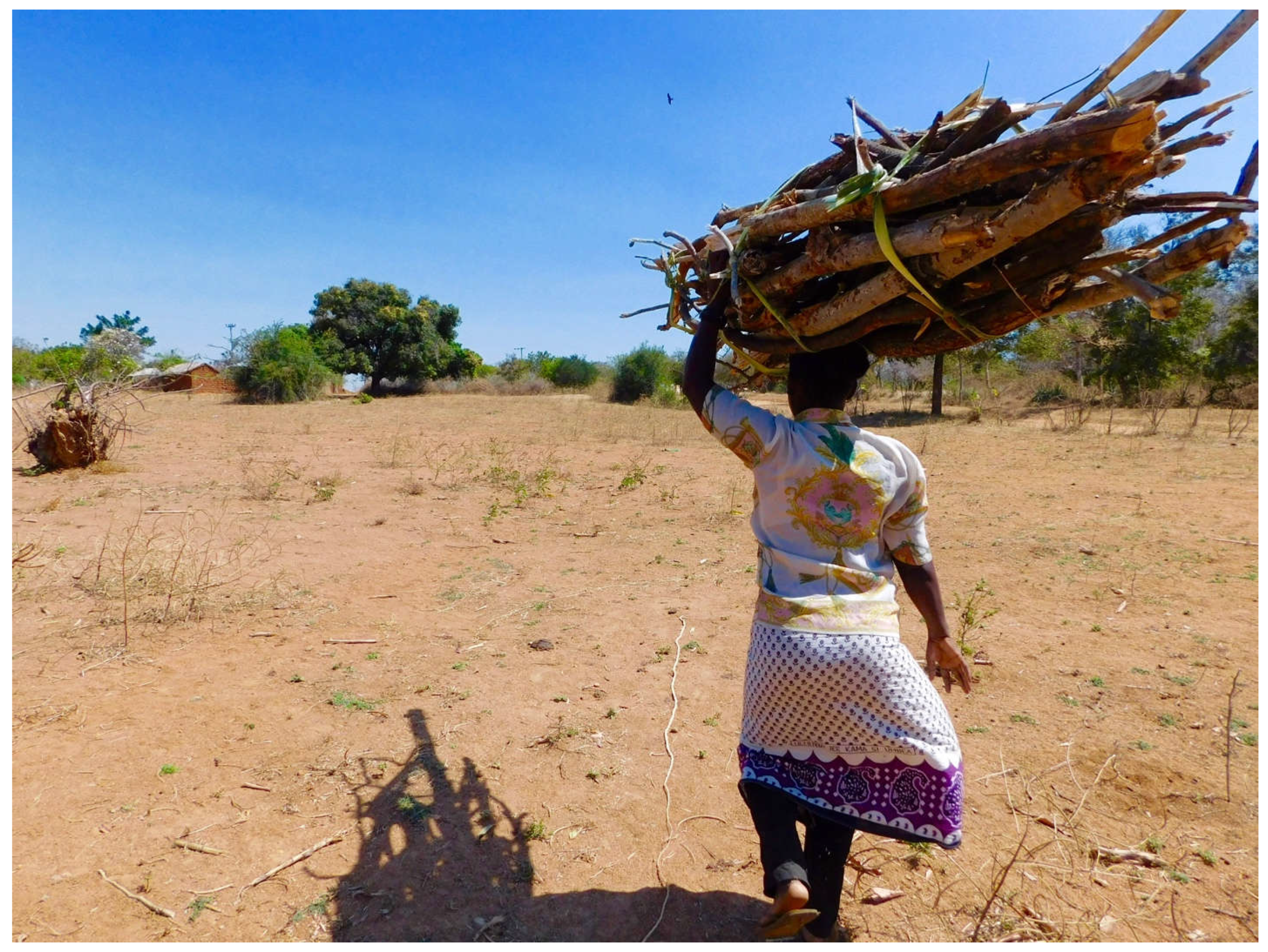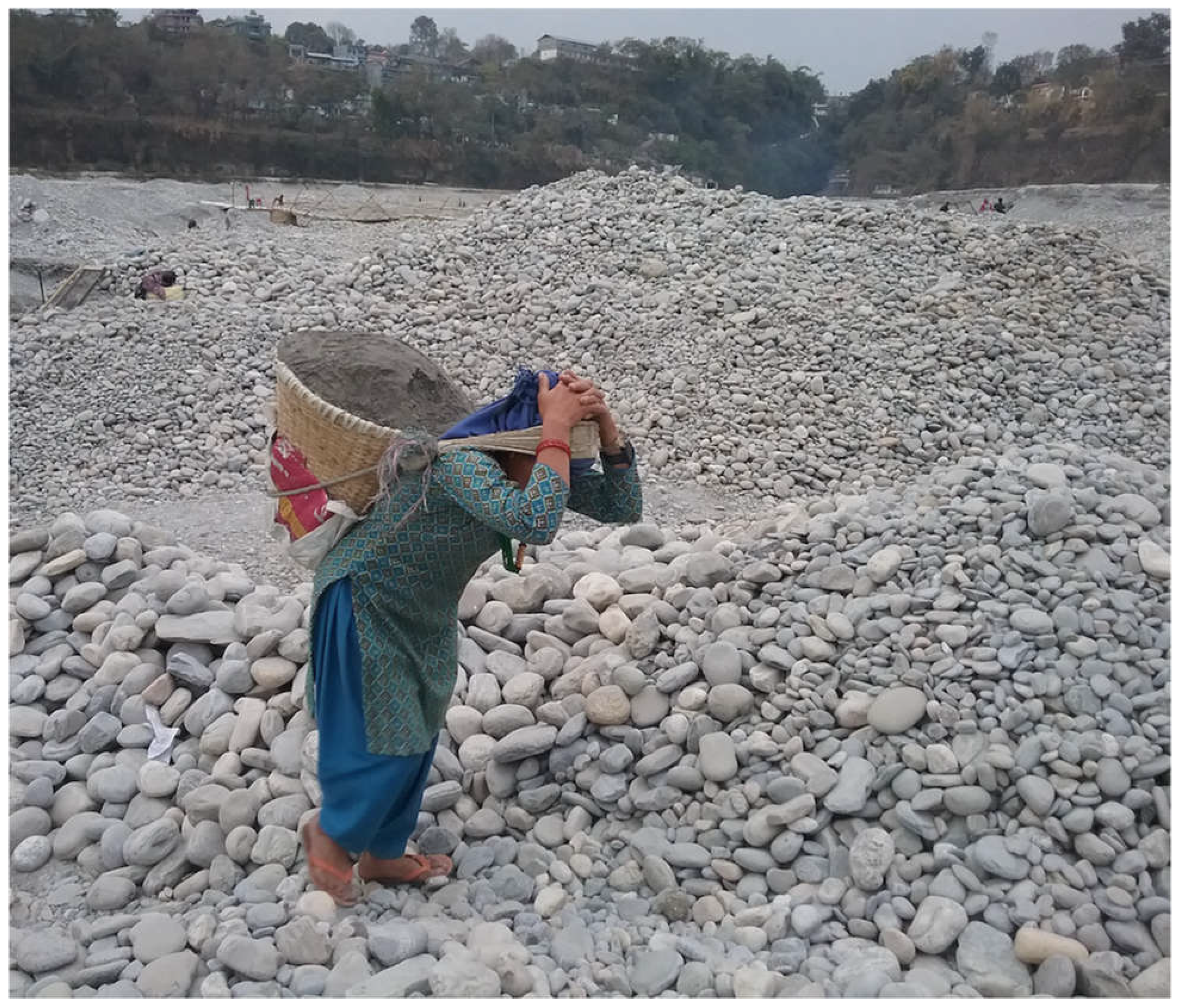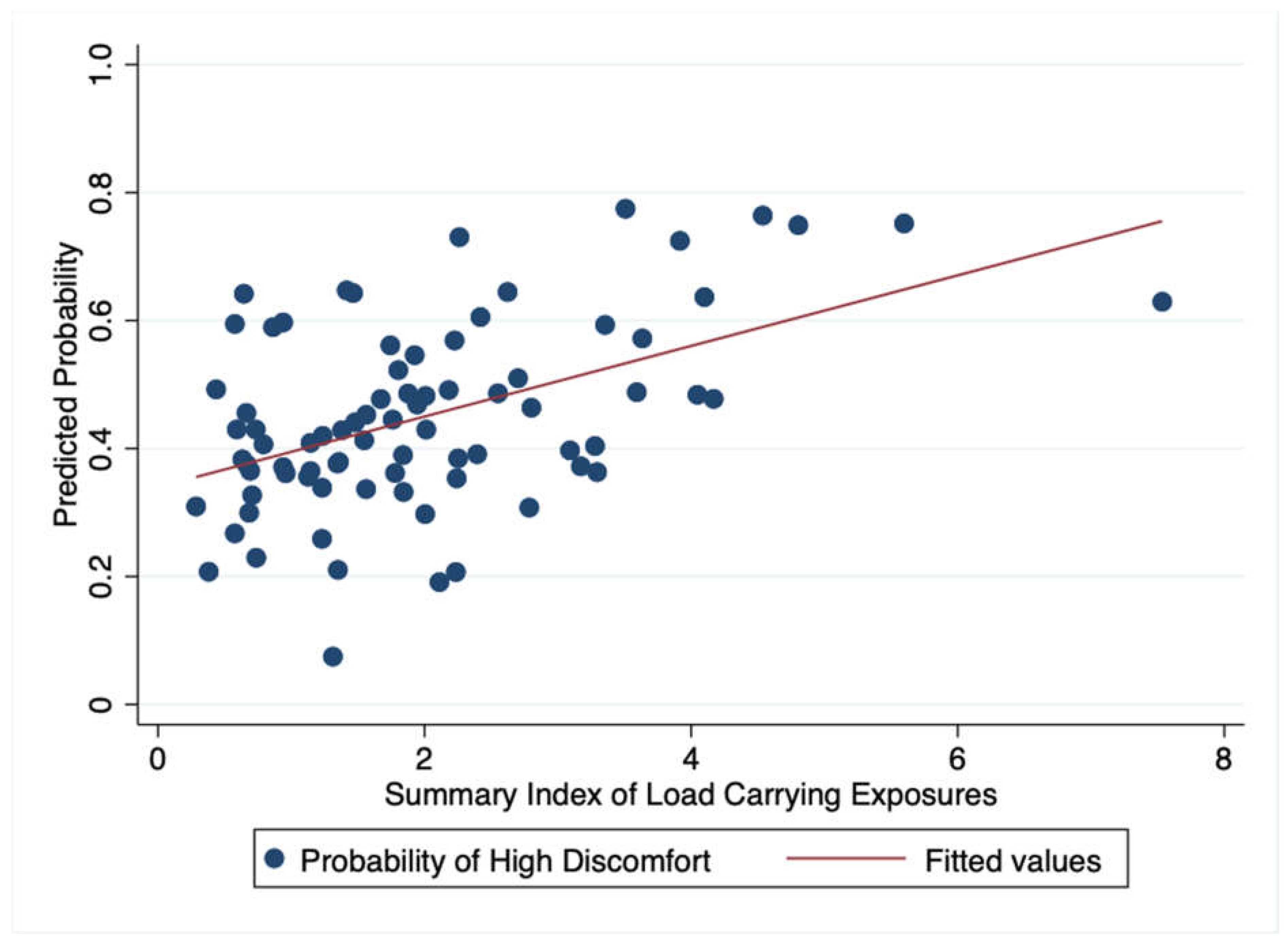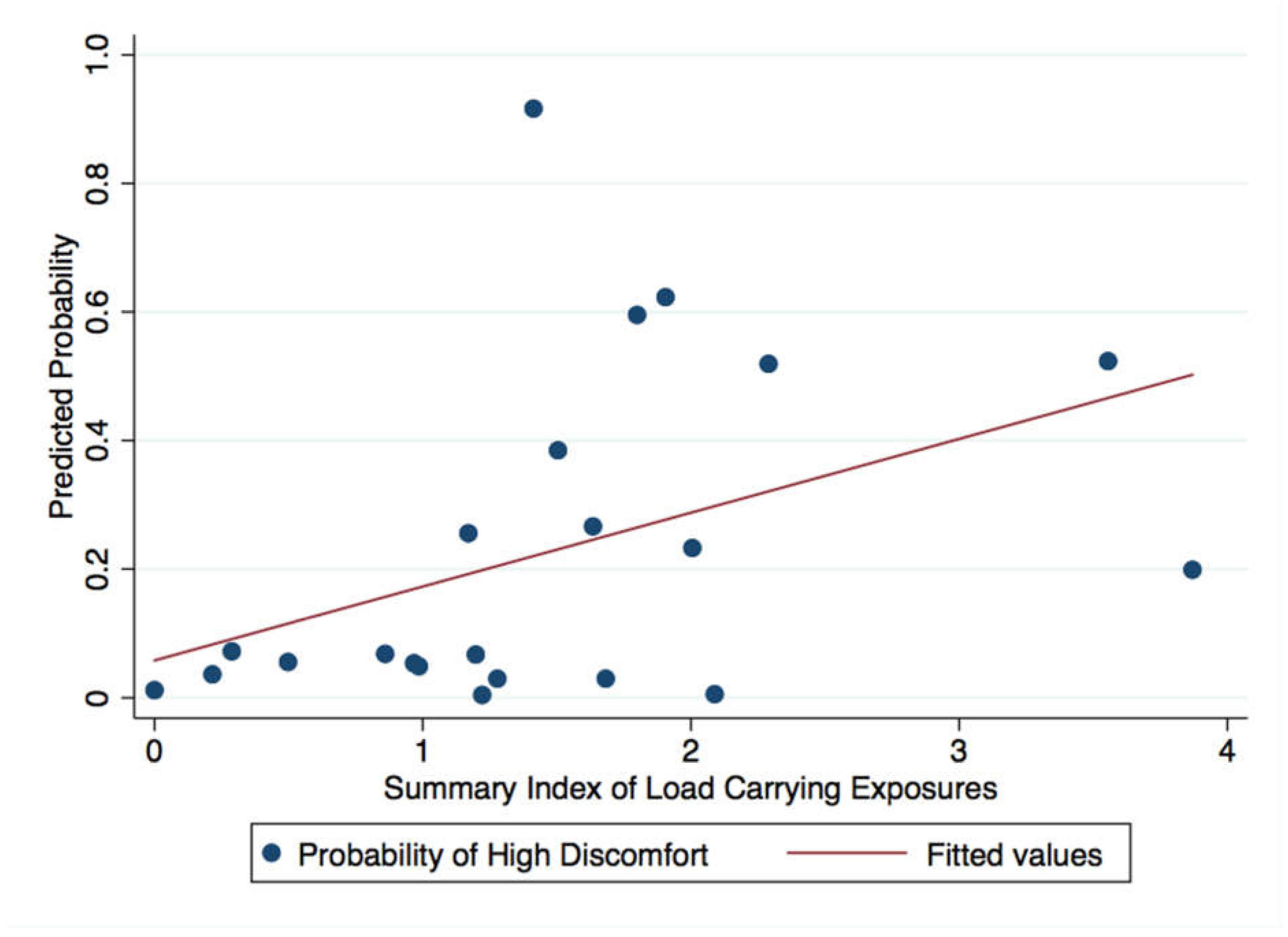Heavy Load Carrying and Symptoms of Pelvic Organ Prolapse among Women in Tanzania and Nepal: An Exploratory Study
Abstract
1. Introduction
2. Materials and Methods
3. Results
3.1. Load-Carrying Exposures
3.2. Symptoms of Lower Abdominal Discomfort Suggestive of POP and POPDI-6 Score
3.3. Load Carrying and Lower Abdominal Discomfort Suggestive of POP
4. Discussion
5. Conclusions
Supplementary Materials
Author Contributions
Funding
Institutional Review Board Statement
Informed Consent Statement
Data Availability Statement
Acknowledgments
Conflicts of Interest
References
- Walker, G.J.A.; Gunasekera, P. Pelvic organ prolapse and incontinence in developing countries: Review of prevalence and risk factors. Int. Urogynecol. J. 2011, 22, 127–135. [Google Scholar] [CrossRef] [PubMed]
- Pelvic Organ Prolapse. WomenshealthGov. 2017. Available online: https://www.womenshealth.gov/a-z-topics/pelvic-organ-prolapse (accessed on 28 January 2021).
- Study on Selected Reproductive Health Morbidities among Women Attending Reproductive Health Camps in Nepal. UNFPA Nepal. 2017. Available online: https://nepal.unfpa.org/en/publications/study-selected-reproductive-health-morbidities-among-women-attending-reproductive-0 (accessed on 3 November 2019).
- Amnesty International. National Alliance for Pelvic Organ Prolapse Management—Nepal. In Proceedings of the Joint-Submission to the United Nations Committee on Economic, Social and Cultural Rights, Nepal, 10–28 November 2014. [Google Scholar]
- Shrestha, B.; Onta, S.; Choulagai, B.; Poudyal, A.; Pahari, D.P.; Uprety, A.; Petzold, M.; Krettek, A. Women’s experiences and health care-seeking practices in relation to uterine prolapse in a hill district of Nepal. BMC Womens Health 2014, 14, 20. [Google Scholar] [CrossRef] [PubMed]
- Amnesty International. Unnecessary Burden: Gender Discrimination and Uterine Prolapse in Nepal; Amnesty International: London, UK, 2014. [Google Scholar]
- Bonetti, T.R.; Erpelding, A.; Pathak, L.R. Listening to “Felt Needs”: Investigating Genital Prolapse in Western Nepal. Reprod. Health Matters 2004, 12, 166–175. [Google Scholar] [CrossRef]
- National Medical Standard for Reproductive Health, Volume II: Other Reproductive Health Issues; Family Health Division: Hawaii, HI, USA, 2003.
- Nygaard, I.E.; Shaw, J.M. Physical Activity And The Pelvic Floor. Am. J. Obstet. Gynecol. 2016, 214, 164–171. [Google Scholar] [CrossRef]
- Jørgensen, S.; Hein, H.O.; Gyntelberg, F. Heavy lifting at work and risk of genital prolapse and herniated lumbar disc in assistant nurses. Occup. Med. 1994, 44, 47–49. [Google Scholar] [CrossRef]
- Woodman, P.J.; Swift, S.E.; O’Boyle, A.L.; Valley, M.T.; Bland, D.R.; Kahn, M.A.; Schaffer, J.I. Prevalence of severe pelvic organ prolapse in relation to job description and socioeconomic status: A multicenter cross-sectional study. Int. Urogynecol. J. 2006, 17, 340–345. [Google Scholar] [CrossRef]
- Majumdar, A.; Saleh, S.; Hill, M.; Hill, S.R. The impact of strenuous physical activity on the development of pelvic organ prolapse. J. Obstet. Gynaecol. 2013, 33, 115–119. [Google Scholar] [CrossRef]
- DeLancey, J.O.L. What’s new in the functional anatomy of pelvic organ prolapse? Curr. Opin. Obstet. Gynecol. 2016, 28, 420–429. [Google Scholar] [CrossRef]
- Porter, G.; Hampshire, K.; Dunn, C.; Hall, R.M.; Levesley, M.; Burton, A.K.; Robson, S.; Abane, A.; Blell, M.T.; Panther, J. Health impacts of pedestrian head-loading: A review of the evidence with particular reference to women and children in sub-Saharan Africa. Soc. Sci. Med. 2013, 88, 90–97. [Google Scholar] [CrossRef]
- Porter, G.; Blaufuss, K.; Acheampong, F.O. Youth, mobility and rural livelihoods in Sub-Saharan Africa: Perspectives from Ghana and Nigeria. Afr. Insight 2008, 37, 420–431. [Google Scholar] [CrossRef]
- Bodner-Adler, B.; Shrivastava, C.; Bodner, K. Risk factors for uterine prolapse in Nepal. Int. Urogynecol. J. 2007, 18, 1343–1346. [Google Scholar] [CrossRef]
- Asresie, A.; Admassu, E.; Setegn, T. Determinants of pelvic organ prolapse among gynecologic patients in Bahir Dar, North West Ethiopia: A case–control study. Int. J. Womens Health 2016, 8, 713–719. [Google Scholar] [CrossRef] [PubMed]
- Masenga, G.G.; Shayo, B.C.; Rasch, V. Prevalence and risk factors for pelvic organ prolapse in Kilimanjaro, Tanzania: A population based study in Tanzanian rural community. PLoS ONE 2018, 13, e0195910. [Google Scholar] [CrossRef] [PubMed]
- Devkota, H.R.; Sijali, T.R.; Harris, C.; Ghimire, D.J.; Prata, N.; Bates, M.N. Bio-mechanical risk factors for uterine prolapse among women living in the hills of west Nepal: A case-control study. Womens Health 2020, 16, 1745506519895175. [Google Scholar] [CrossRef] [PubMed]
- Koyuncu, A. Heavy load carrying and musculoskeletal health: An exploratory study of sand miners in Pokhara, Kaski District, Nepal. medRxiv 2020. [Google Scholar] [CrossRef]
- Kadota, J.L.; McCoy, S.I.; Bates, M.N.; Mnyippembe, A.; Njau, P.F.; Prata, N.; Harris-Adamson, C. The Impact of Heavy Load Carrying on Musculoskeletal Pain and Disability Among Women in Shinyanga Region, Tanzania. Ann. Glob. Health 2020, 86, 17. [Google Scholar] [CrossRef] [PubMed]
- Jolliffe, I.T.; Cadima, J. Principal component analysis: A review and recent developments. Philos. Trans. R. Soc. A Math. Phys. Eng. Sci. 2016, 374, 20150202. [Google Scholar] [CrossRef]
- Mattsson, N.K.; Nieminen, K.; Heikkinen, A.-M.; Jalkanen, J.; Koivurova, S.; Eloranta, M.-L.; Suvitie, P.; Tolppanen, A.-M. Validation of the short forms of the Pelvic Floor Distress Inventory (PFDI-20), Pelvic Floor Impact Questionnaire (PFIQ-7), and Pelvic Organ Prolapse/Urinary Incontinence Sexual Questionnaire (PISQ-12) in Finnish. Health Qual. Life Outcomes 2017, 15, 88. [Google Scholar] [CrossRef]
- Barber, M.D.; Kuchibhatla, M.N.; Pieper, C.F.; Bump, R.C. Psychometric evaluation of 2 comprehensive condition-specific quality of life instruments for women with pelvic floor disorders. Am. J. Obstet. Gynecol. 2001, 185, 1388–1395. [Google Scholar] [CrossRef]
- Rogers, R.G.; Kammerer-Doak, D.; Villarreal, A.; Coates, K.; Qualls, C. A new instrument to measure sexual function in women with urinary incontinence or pelvic organ prolapse. Am. J. Obstet. Gynecol. 2001, 184, 552–558. [Google Scholar] [CrossRef]
- Earth, B.; Sthapit, S. Uterine Prolapse in Rural Nepal: Gender and Human Rights Implications. Mandate Dev. Cult. Health Sex. 2002, 4, 281–296. [Google Scholar] [CrossRef]
- Megabiaw, B.; Adefris, M.; Rortveit, G.; Degu, G.; Muleta, M.; Blystad, A.; Kiserud, T.; Melese, T.; Kebede, Y. Pelvic floor disorders among women in Dabat district, northwest Ethiopia: A pilot study. Int. Urogynecol. J. 2013, 24, 1135–1143. [Google Scholar] [CrossRef] [PubMed]
- Gjerde, J.L.; Rortveit, G.; Muleta, M.; Blystad, A. Silently waiting to heal. Int. Urogynecol. J. 2013, 24, 953–958. [Google Scholar] [CrossRef] [PubMed]
- Scherf, C.; Morison, L.; Fiander, A.; Ekpo, G.; Walraven, G. Epidemiology of pelvic organ prolapse in rural Gambia, West Africa. BJOG Int. J. Obstet. Gynaecol. 2002, 109, 431–436. [Google Scholar] [CrossRef] [PubMed]
- Hondras, M.; Hartvigsen, J.; Myburgh, C.; Johannessen, H. Everyday burden of musculoskeletal conditions among villagers in rural Botswana: A focused ethnography. J. Rehabil. Med. 2016, 48, 449–455. [Google Scholar] [CrossRef]
- Ministry of Health, Community Development, Gender, Elderly and Children (MoHCDGEC). 2015–16 TDHS-MIS Key Findings. Rockville, ML, USA: Tanzania Mainland, Ministry of Health (MoH) [Zanzibar]; National Bureau of Statistics (NBS); Office of the Chief Government Statistician (OCGS); ICF: Washington, DC, USA, 2016.
- Nepal Demographic and Health Survey. 2011. Available online: https://dhsprogram.com/pubs/pdf/FR257/FR257%5B13April2012%5D.pdf (accessed on 31 January 2021).




| Participant Characteristic | Tanzania (N = 80) | Nepal (N = 22) | ||
|---|---|---|---|---|
| Mean (SD) | N (%) | Mean (SD) | N (%) | |
| Age (years) | 31.6 (12.2) | 36.1 (8.1) | ||
| 18–30 | 47 (57.3) | 8 (36.4) | ||
| >30 | 26 (31.7) | 14 (63.6) | ||
| Unknown | 9 (11.0) | 0 (0.0) | ||
| BMI (kg/m2) | 24.4 (4.2) | 24.7 (3.7) | ||
| Underweight (<18.5) | 2 (2.4) | 1 (4.6) | ||
| Normal (18.5–25) | 55 (67.1) | 11 (50.0) | ||
| Overweight (>25) | 27 (32.9) | 10 (45.5) | ||
| Marital status | ||||
| Married/with partner | 61 (74.4) | 17 (77.3) | ||
| Unmarried/Single/Divorced/Separated | 21 (25.6) | 4 (22.7) | ||
| Caste/ethnicity A | ||||
| Dalit | 5 (22.7) | |||
| Brahmin/chhetri | 1 (4.6) | |||
| Janajati | 16 (72.7) | |||
| Primary Occupation | ||||
| Farmer | 78 (95.1) | 0 (0.0) | ||
| Sand miner | 0 (0.0) | 22 (100.0) | ||
| Other | 4 (4.9) | 0 (0.0) | ||
| Years working as a sand miner | - | - | 8.4 (9.3) | |
| Parity | 4.0 (2.5) | 3.4 (2.2) | ||
| 0–3 children | 45 (54.9) | 13 (59.1) | ||
| ≥4 children | 37 (45.1) | 9 (40.9) | ||
| Number of lifetime pregnancies | 4.4 (3.1) | 3.9 (2.5) | ||
| None | 3 (3.7) | 2 (9.1) | ||
| 1–2 pregnancies | 13 (15.9) | 6 (27.3) | ||
| 3–4 pregnancies | 33 (40.2) | 5 (22.7) | ||
| ≥5 pregnancies | 33 (40.2) | 9 (40.9) | ||
| Age at first child (years) | 18.1 (2.2) | 19.7 (4.5) | ||
| 13–19 years | 42 (52.5) | 10 (45.5) | ||
| ≥19 years | 24 (30.0) | 10 (45.5) | ||
| Missing | 16 (20.0) | 2 (9.1) | ||
| Characteristic | Tanzania | Nepal | ||||
|---|---|---|---|---|---|---|
| Median (IQR) | Overall (N = 80) | Low Load Carrying A (n = 40) | High Load Carrying A (n = 40) | Overall (N = 22) | Low Load Carrying (n = 11) | High Load Carrying (n = 11) |
| Weight of load (kgs) | 20.0 (13.2–22.2) | 19.2 (11.8–21.5) | 20.0 (17.3–23.0) | 65.5 (57.5–70.1) | 69.8 (64.9–79.7) | 57.5 (54.9–66.5) |
| Duration per load (mins) B | 30 (15–30) | 20 (15–30) | 30 (20–35) | 0.1 (0.0–0.0) | 0.1 (0.0–0.0) | 0.1 (0.0–4.0) |
| Number of loads per week | 16.5 (9–32) | 11 (5.5–14) | 33.5 (22.5–36) | 164.5 (120.0–280.0) | 140.0 (100.0–175.0) | 210.0 (140.0–700.0) |
| Symptoms of Lower Abdominal Discomfort | Tanzania (N = 80) | Nepal (N = 22) | ||||
|---|---|---|---|---|---|---|
| N (col %) | Unadjusted PD (95% CI) | Adjusted PD (95% CI) | N (col %) | Unadjusted PD (95% CI) | Adjusted 1 PD (95% CI) | |
| Pain urinating | ||||||
| No | 32 (39.0) | 0.00 (ref) | 0.00 (ref) | 14 (63.6) | 0.00 (ref) | 0.00 (ref) |
| Yes | 50 (61.0) | 11.9 ** (4.7, 19.1) | 11.2 ** (4.1, 18.4) | 8 (36.4) | 14.9 * (3.7, 26.1) | 15.1 * (3.6, 26.7) |
| Problems holding urine | ||||||
| No | 59 (73.8) | 0.00 (ref) | 0.00 (ref) | 18 (81.8) | 0.00 (ref) | 0.00 (ref) |
| Yes | 21 (26.3) | 9.4 ** (6.7, 12.1) | 9.5 ** (6.8, 12.1) | 4 (18.2) | 1.4 (−15.4, 17.8) | 3.4 (−14.2, 20.9) |
| Pressure in lower abdomen | ||||||
| No | 42 (52.5) | 0.00 (ref) | 0.00 (ref) | 20 (90.9) | 0.00 (ref) | 0.00 (ref) |
| Yes | 38 (47.5) | 11.0 ** (8.4, 13.6) | 10.7 ** (8.1, 13.4) | 2 (9.1) | 33.3 ** (17.7, 49.0) | 36.6 ** (22.3, 51.0) |
| Heaviness/dullness in pelvic area | ||||||
| No | 42 (52.5) | 0.00 (ref) | 0.00 (ref) | 18 (81.8) | 0.00 (ref) | 0.00 (ref) |
| Yes | 38 (47.5) | 11.7 ** (9.1, 14.2) | 11.6 ** (8.9, 14.3) | 4 (18.2) | 31.9 ** (25.0, 38.9) | 31.8 ** (24.9, 38.7) |
| Bulge in vagina | ||||||
| No | 68 (85.0) | 0.00 (ref) | 0.00 (ref) | 21 (95.5) | 0.00 (ref) | 0.00 (ref) |
| Yes | 12 (15.0) | 12.1 ** (8.8, 15.4) | 11.7 ** (8.4, 15.0) | 1 (4.6) | 18.7 (−10.5, 47.8) | 12.8 (−23.9, 49.5) |
| Country | Heavy Load Carrying | Mean Discomfort Score (SD) | Unadjusted PD (95% CI) | Adjusted PD 1 (95% CI) |
|---|---|---|---|---|
| Tanzania | Low | 16.4 (14.8) | 0.00 (Ref) | 0.00 (Ref) |
| High | 19.8 (18.7) | 3.4 (−4.1, 11.0) | 3.7 (−3.8, 11.3) | |
| Nepal | Low | 4.5 (8.4) | 0.00 (Ref) | 0.00 (Ref) |
| High | 13.1 (17.1) | 8.50 (−3.5, 20.5) | 9.3 (−4.9, 23.6) |
Publisher’s Note: MDPI stays neutral with regard to jurisdictional claims in published maps and institutional affiliations. |
© 2021 by the authors. Licensee MDPI, Basel, Switzerland. This article is an open access article distributed under the terms and conditions of the Creative Commons Attribution (CC BY) license (http://creativecommons.org/licenses/by/4.0/).
Share and Cite
Koyuncu, A.; Kadota, J.L.; Mnyippembe, A.; Njau, P.F.; Sijali, T.R.; McCoy, S.I.; Bates, M.N.; Harris-Adamson, C.; Prata, N. Heavy Load Carrying and Symptoms of Pelvic Organ Prolapse among Women in Tanzania and Nepal: An Exploratory Study. Int. J. Environ. Res. Public Health 2021, 18, 1279. https://doi.org/10.3390/ijerph18031279
Koyuncu A, Kadota JL, Mnyippembe A, Njau PF, Sijali TR, McCoy SI, Bates MN, Harris-Adamson C, Prata N. Heavy Load Carrying and Symptoms of Pelvic Organ Prolapse among Women in Tanzania and Nepal: An Exploratory Study. International Journal of Environmental Research and Public Health. 2021; 18(3):1279. https://doi.org/10.3390/ijerph18031279
Chicago/Turabian StyleKoyuncu, Aybüke, Jillian L. Kadota, Agatha Mnyippembe, Prosper F. Njau, Tula Ram Sijali, Sandra I. McCoy, Michael N. Bates, Carisa Harris-Adamson, and Ndola Prata. 2021. "Heavy Load Carrying and Symptoms of Pelvic Organ Prolapse among Women in Tanzania and Nepal: An Exploratory Study" International Journal of Environmental Research and Public Health 18, no. 3: 1279. https://doi.org/10.3390/ijerph18031279
APA StyleKoyuncu, A., Kadota, J. L., Mnyippembe, A., Njau, P. F., Sijali, T. R., McCoy, S. I., Bates, M. N., Harris-Adamson, C., & Prata, N. (2021). Heavy Load Carrying and Symptoms of Pelvic Organ Prolapse among Women in Tanzania and Nepal: An Exploratory Study. International Journal of Environmental Research and Public Health, 18(3), 1279. https://doi.org/10.3390/ijerph18031279






